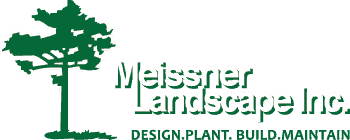For successful germination and a healthy lawn there are four major areas which need to be addressed. These include watering, soil fertility, mowing, and weed/insect control.
Watering
Improper watering causes more failures in newly seeded lawns than any other factor. Seeded areas need to be kept moist at all times until approximately one inch of growth is visible.
This means that upon completion of seeding, your new lawn will require a thorough soaking. Stop just before water begins to puddle and run off. Pay close attention to perimeter areas, areas near obstacles and areas near buildings, making sure these receive adequate water.
After this initial watering, continue with a daily watering program. More watering will be required on hot, windy days and less on cool, calm, shady days. Again stop watering just before puddling and runoff occur. Once the seeds have germinated, allowing the soil to dry out even one time can result in the death of these tender plants.
If the above directions are followed and the temperature remains above 60 degrees, good germination should occur in approximately 2 weeks.
Upon successful germination, and after the lawn has grown to 1.5”–2” you can begin to water less frequently. Again, keep in mind that all areas require a deep soaking. By doing this you are working toward the development of a deep, strong root system for the plants. This usually requires 1-2 waterings per week. As a guide, lawns require about 1” of water per week including rainfall.
It is important to understand that a good watering program is dependant on you, the homeowner. By getting to know your lawn through close observation, and understanding how wind, temperature, soil conditions, humidity and rainfall all impact water requirements, you will be able to make sound decisions on the water schedule you chose.
Fertilization
When your lawn was seeded, it was also fertilized. This will remain effective for approximately 30 days. Because of the frequent watering and the amount of nutrients a new, actively growing lawn requires, we strongly recommend a second application after this period.
After the lawn becomes established, approximately 5-6 mowings, we recommend a program which includes two fertilizer applications per year, one in spring and the second in late summer-early fall. Some homeowners opt for a third application which would be applied in late October or early November.
It is also recommended that you use a ‘brand name’, slow release product. Follow the manufacturers suggested rates and apply it to lawns that are not wet from dew, recent rains, or irrigation.
Mowing
The first mowing should take place when your lawn is 2.5”-3” high. Do not remove more than 1/3 of the plant’s leaf surface. This could put the lawn under stress which in turn could lead to disease and/or insect problems.
If straw or some other type of mulch was applied when the seeding was done it should not be removed. It will decompose adding organic material to the soil.
New seedlings are also finer in texture than established plants. Waiting too long to mow, results in the plants falling over. This makes it hard, if not impossible, to cleanly cut them at the correct height.
By more frequent mowing, the above problem can be eliminated. This will also result in fewer clippings which can be left on the lawn to provide nutrients. If you wait too long between mowings, clippings may need to be removed to prevent this debris from smothering out the lawn. Again, remember to never cut your lawn lower than 2.5”.
Weed Control
As the lawn germinates you can expect to see some weeds sprouting as well. Weed seeds are always present in new and existing topsoil. The majority are annuals which will not return the following year providing proper cultural practices are followed.
No herbicides can be applied to a new lawn for a minimum of 90 days after germination.
After this time a broadleaf weed herbicide may be applied to control perennial weeds if necessary or desired. We recommend the use of liquid herbicides, applying them in mid-May or preferably mid-September. Pay close attention to the label for rate of application, precaution statements, and other important information.
Insect And Disease Control
If your lawn should develop an insect or disease problem in the future, the most important aspect of treating it is the correct diagnosis. Once identified, the safest, most effective treatment can be applied. The best defense against problems like these is to maintain a healthy lawn by establishing a sound watering, fertilization, mowing, and weed control program.
If you have any questions concerning these instructions or if you encounter any problems as you work to establish your lawn, please feel free to give us a call.

